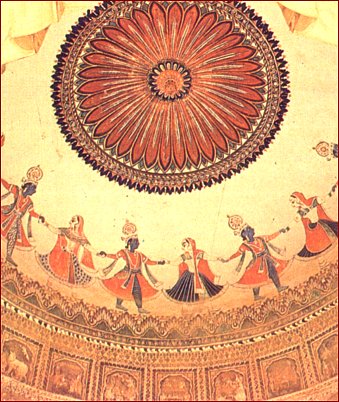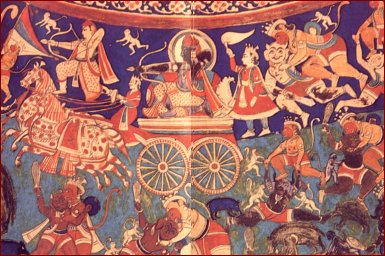STATES AND UNION TERRITORIES OF INDIA
RAJASTHAN
Shekhawati
Shekhawati
(land of Shekha) owes its name to Rao Shekha (1433-1488), who was a cousin
of the Kachchawahas of Jaipur. He challenged them, declaring independence
and Jaipur was able to reassert its might again only in 1738.
This place
often known as the "Open Art Gallery of Rajasthan", reveals wonderful wall
paintings portraying images from traditional mythology, folklore &
heroes. Frescoes painted with natural pigments are found in the Gopinath
temple and the cenotaph of Shardul Singh. Several frescoes have also
been executed in the mansions.
Jhunjhunu,
the new capital was a stronghold of the Kayamkhani Nawabs till 1730.
Hindu rule was then established by Shardul Singh. Wonderful frescoes are
painted in the havelis of Tibriwals, the Modis, at the Khetri Mahal &
the Bihariji temple.
Other places
of interest are Badalgarh, Jorawargarh, Mertani Baori, Kamruddin Shah ki
Dargah, Birdi Chand ka Kuan, Ajit Sagar and Jain temple.
Sikar was founded
in the late 17th century. There are fine samples of frescoes in the
Gopinath, Raghunath and Madan Mohan temples. The main centres of
Shekhawati art in this district are at Ramgarh, Fatehpur and Lachhmangarh.
The Harshnath
temple (10th century) with its splendid architecture is located on
Harsh Nath hills about 11kms from Sikar.
Jeen Mata temple
is located 29 kms from Sikar. This temple is believed to have been
constructed 1000 years ago. The fair during April - May draws devotees.
Lachhmangarh
was founded in the early 19th century by Raja Lachhman Singh of Sikar.
This town follows the wonderful town planning of Jaipur. The places
of interest here are the Ganeriwala haveli (the grandest in Shekhawati),
Murlimanohar temple and the Chokhani havelis.
Fatehpur was
founded in the mid 15th century by Fateh Khan, a Kayamkhani Nawab.
The havelis of Devra, Singhania, Goenka, Saraogi are famous for the frescoes.
This place is famous for the tie and dye fabrics.
Ramgarh was
founded in the late 18th century by the Poddars. Exquisite paintings
are found on the ceilings of the chhatris. Other spots of interest
are the Sani temple & temple to Ganges, the havelis of the Poddars
and Ruias.
Khatu Shyamji
village is famous for the Shyamji temple built in white marble. There
are a few other temples & a lake.


Frescoes
|